


 |
August 24-28: A Visit to Hong Kong |
 |
August 12-18: A Business Trip to Sydney |
 |
Return to Index for 1978 |
On Saturday, after the classwork in Sydney was done, I continued on my vacation, and in the morning checked in for a flight to Bangkok, Thailand, on Singapore Airlines.
Traveling from Sydney to Bangkok
|
|
While places overseas are great to visit, getting there is a real pain as the distances are so great. We get used to 2-4 hour flights in the States to get just about anywhere, but to get to another continent you are in the 8-10 hour range. And Asia is even further- 16 hours or so, depending on where you're going. And sometimes there are refueling stops and that just makes the trip longer.
I took some pictures from my window as we flew, but only one of them turned out at all. Flying across the Australian continent, here from the air is an ancient riverbed of what must have been (and still is during the rainy season) quite a major system. Note how barren the country is. This area, part of the outback, is not even used for sheep.
Late in the day, I took three other pictures, but we were so high and the light was so bad that none of them turned out. We eventually crossed the country (about four hours) and then headed out over the Western coast to Southeast Asia. During the night we will be crossing the Equator again, back into Summer.
We landed briefly in Singapore, where I changed planes for the continuing flight to Bangkok. There wasn't much to see at the Singapore airport, mostly because it was the middle of the night. Most officials spoke some English, and all the important signs were in two languages, so transit was not difficult. In the morning we approached Thailand, and I tried to get a picture of the Thai coastline, but there wasn't enough light at ground level to illuminate it for me.
At the Hyatt Rama in Bangkok
|
|
I didn't take the picture at right of the lobby of the hotel; I found it online. But not on the website for the hotel, as there isn't one. As I am wont to do when creating these album pages (particularly for trips that are not recent), I wanted to find the hotel on a map or aerial view of Bangkok so I could note exactly where it was. Sadly, no amount of searching for "Hyatt Rama" gave me any information. So I did two things.
First, I found a contact email for the Bangkok Tourist Office, and I sent them a message with a picture of the hotel and a picture of the street in front of it, asking them if they could locate it for me. At the time of this writing, I have not heard back. But the other thing I did was to contact the Hyatt Hotels Corporation. I found an email address for their Far East manager, and so I sent her the same email. I did hear back from her office. What they told me was that in the 1980s, when the Hyatt chain was going more upscale, the hotel was sold. It is now, they tell me, the Holiday Inn Bangkok Silom, and I have been able to locate it on the aerial view. Interestingly, what was the tallest building around is now nestled in between much taller ones, even though the Holiday Inn itself has been expanded. I can't really tell from the views if the hotel was torn down and rebuilt, or whether another tower was just added, but the hotel is actually still there, though no longer a Hyatt. The hotel was very nice, and inside were all the shops and stuff that one would expect in a tourist hotel, and, on the ledge in view here, the swimming pool. The Hyatt Rama was only a half mile, as I recall, from the Chao Phraya River; some of the most famous temples are on its banks. The Hyatt Rama, my hotel, was much like any stateside hotel, although there were some subtle differences (the lack of an easily-accessible ice machine, for one thing).
I don't know what I really expected in Bangkok. What I found was a city of contrasts. On the one hand, there were the obvious accoutrements of modern civilization. On the streets outside were modern automobiles, the great majority of them Japanese. In the nicer sections of the city, it looked much like Tokyo, or even San Francisco's Chinatown.
|
As in Seoul, most of the proprietors of these shops lived either in the shop itself or over it and, by and large, the buildings were wooden, with some concrete and lots of galvanized tin roofing. There was very little wood, which I assume does not last long in the hot, wet climate. At left is the street right outside the Hyatt. The weather was very warm, but not quite oppressive.
Bangkok is the capital and most populous city of Thailand; it occupies 600 square miles in the Chao Phraya River delta in central Thailand, and at the time of my visit had a population of over three million (in the ensuing years, that figure has more than tripled, reaching some 14 million in the area by 2010). Bangkok is by far Thailand's most important urban center.
Bangkok traces its roots to a small trading post dating from the 15th century, which eventually grew and became the site of two capital cities: Thonburi in 1768 and Rattanakosin in 1782. Bangkok was at the heart of the modernization of Siam, later renamed Thailand, during the late 19th century, as the country faced pressures from the West. The city was at the center of Thailand's political struggles throughout the 20th century, as the country abolished absolute monarchy, adopted constitutional rule, and underwent numerous coups and several uprisings. The city grew rapidly during the 1960s and this decade, and shows no signs of slowing down.
|
So what did I go see? Today, as I'll explain below, I was able to take a boat ride to one of Bangkok's smaller "floating markets", a boat ride that took me up the Chao Phraya river to a smaller waterway, the Bangkok Noi, which led up to the northwest not only to the floating market but also my first Buddhist temple, the Wat Taling Chan.
The next day, I took an official tour on the river and to some more Buddhist sites, including the Wat Arun. I also had an up-close and personal encounter with an elephant.
On my third day, I took another tour, this time on land, to the Temple of the Emerald Buddha as well as Thailand's Royal Palace. I've marked these locations on the aerial view, so you can get an idea of where they were located relative to each other.
I began today just by walking down towards the river, as I'd learned at the hotel that many of Bangkok's best scenery is to be found there. Along the way, I passed through fairly typical, non-touristy areas of the city, and could see what day to day life might be like for its residents. When a nation is making every effort to modernize and grow, it seems, urban beautification is low on the list of priorities.
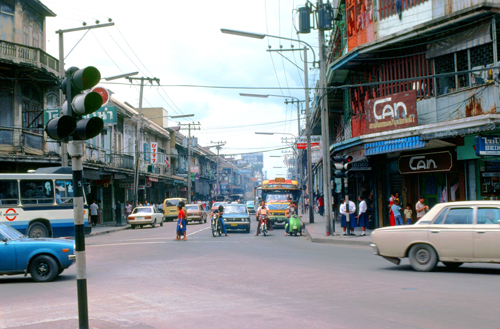 Standing by the stop light are some schoolgirls in the common uniform. This uniform has been the same in Korea, Japan, and now, Thailand. I wonder if it is a worldwide conspiracy? |
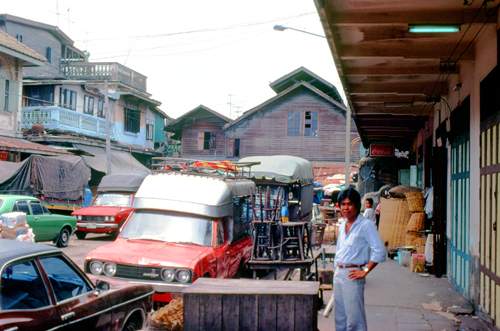 This is what I mean about the side streets. The shop on the right sells rice, and in the near ground, furniture (stools). |
Taling Chan Floating Market
|
He was politely insistent about showing me around parts of Bangkok. He mentioned the canals, and the sightseeing that could be done along them, and, before I could say much, he had negotiated for a boat like the one you can see in my picture at left, and we took off for a ride.
I admit I should have politely, but just as insistently, declined his offer to be a tour guide for a while, and I was pretty sure I was going to be scammed, but I was tired from my travel and basically just gave up.
P> In any event, he gave the boatsman some instructions in Thai (looking back on it that he would be cutting the boatman in on whatever he might be able to get out of me) and then explained to me in English that we would be able to visit the Taling Chan Floating Market.
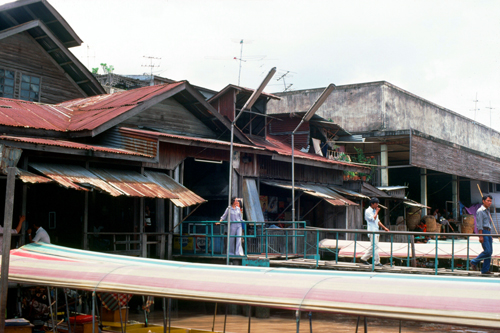 Along the way, we passed many typical Thai residences, many of which are situated along the various canals- like this one. |
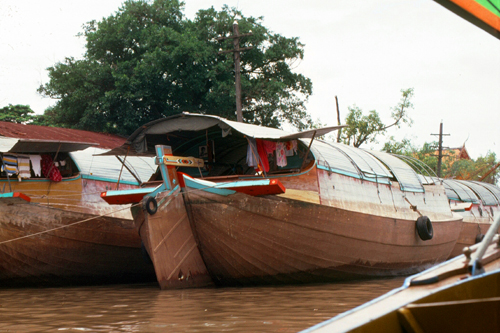 Not all of the boats are small. The ones used for larger cargo look like this, and often have living space for the owners inside. I got the impression that some of the boats carry no cargo, but are just like houseboats. |
Probably most of the Thais who live in the kind of housing that we saw along the canals have something to do with the commercial use of the waterways, but then it's also possible that just living on a waterway is desirable. It was quite warm today, but not as oppressive as one might think- what with all the water and all.
|
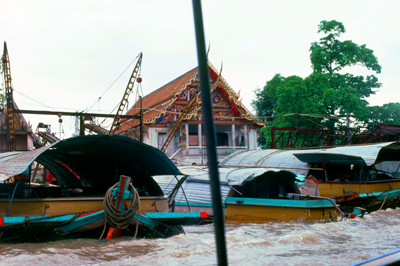 All along the canals the boats are lined up along the wharves. These boats were tied up in front of some religious buildings. It is probably about as hard to find a place to tie up your boat as it is to find a parking space in the city. |
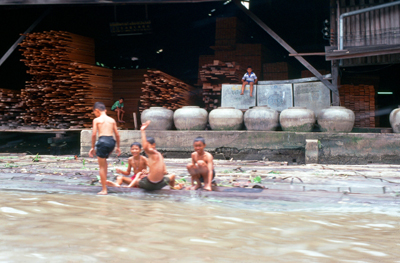 At many places along the canals, one can spot women washing clothing and the every-present children using the canals as a playground. Here are some typical kids playing on a raft of logs in the canal. |
As I recall, this was early afternoon on a weekday, but I confess I don't have any idea about whether these kids should have been in school, or whether they even attend. We just tend to take all that kind of stuff for granted. We did go by the floating market, but unlike some in the city it was quite small, and basically just six or eight boats tied up together offering various food and notion items for sale. Then our little boat tied up at Wat Taling Chan (a monastery/Buddhist temple).
Taling Chan Buddhist Temple (Wat Taling Chan)
|
|
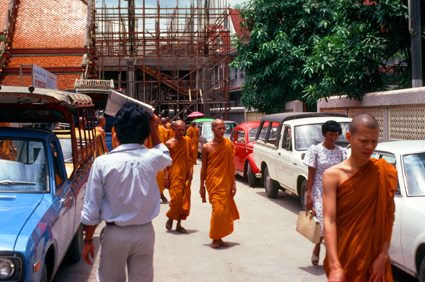 |
Note, too, the construction going on in the monastery grounds. I did not see any monks when I was out and about in the commercial areas of the city. I wasn't sure why, not being an expert on Buddhist practices. Either they dress differently there, or they simply don't leave the temple grounds very often. This temple was begun around 1828; according to temple records a wealthy man with the family name Chan donated the land for the temple. Its original name was Thai for "The Ascetic Temple", but over a century later its name was changed to the formal "Wat Chan Pradittharam". It is locally known as Wat Taling Chan (Temple Chan in Taling).
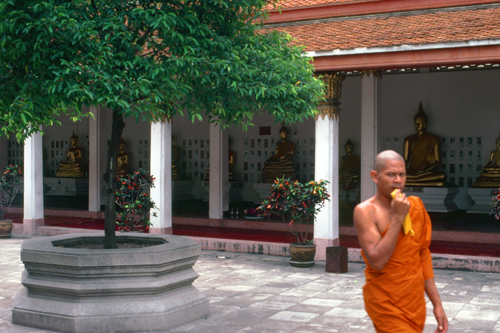 Here is a part of the monastery, with the gold-leaf-covered Buddhas on the porch. |
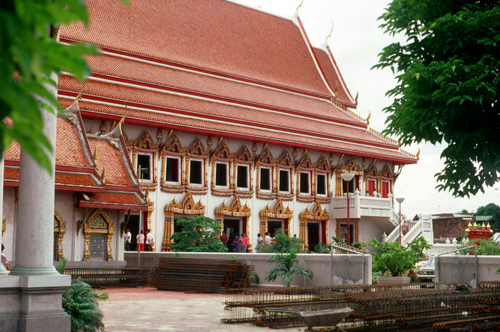 This particular monastery is supposedly one of the most beautiful in the city; it has multiple patrons. |
Outsiders (and I imagine many Thais as well) are not allowed inside the buildings, or at least many of them. While this particular monk looks somewhat displeased, I did not get the impression that they did not want their pictures taken, a phobia which some other far-Eastern cultures have. More likely he was just lost in thought.
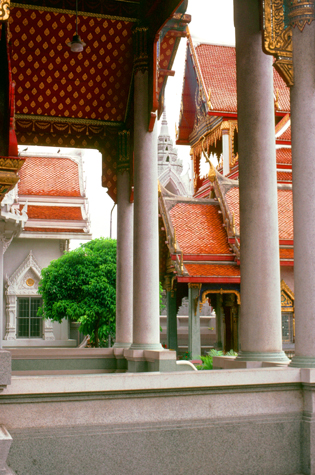 Intricate Carvings and Rich Colors |
(Picture at left) Compare this with the pictures of the Nikko Shrine in Japan, and you can detect a common thread of influence, at least in religious building. There is the same use of carving and color, although the subjects are different. The Japanese carve animals and birds and flowers, which all have some significance, while the Thai carve more abstract patterns. I get the impression that Buddhism places much less importance on nature, and more on one's relationship to it.
(Picture at right)
|
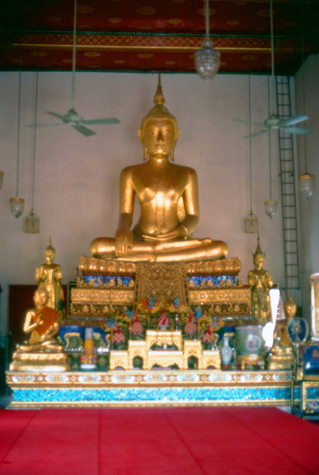 The Temple's Main Buddha |
Wandering around the temple grounds was immensely interesting, and my young guide seemed to know quite a bit about the history of this particular temple.
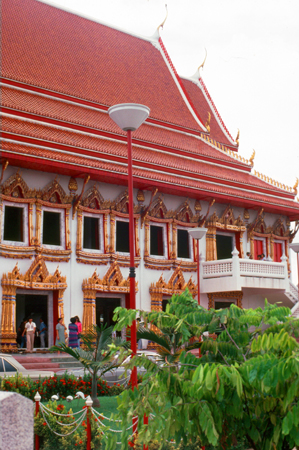 |
(Picture at left) Here is another view of the exterior of the building containing the Buddha.
(Picture at right)
|
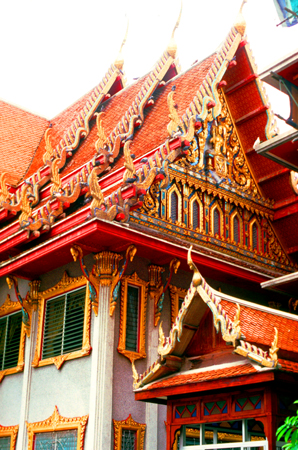 |
Returning to the boat, we retraced our path back down the canal system to the river, and turned back south heading for about the place where we started out.
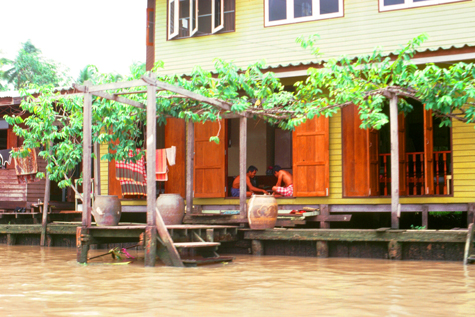 This is a very above-average residence. There is no commercial use here, and this says that the owner can afford the luxury of occupying valuable canal-side space for a residence only. It looks like the two kids are playing Go or some other game. The pots are probably for fresh water. |
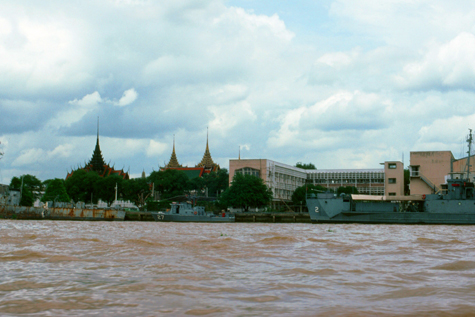 When we reached the river and headed south, we passed what appeared to be a large government building, what with the military craft and all. Next to it were the spires of another temple- one that I would visit the next day, as it turned out. |
At the end of my "guided tour," my earlier suspicions were confirmed, as my "guide" looked to me to pay for the boat- about $25US as I recall. Misunderstanding or scam, I'm not sure, but in any case I did not have that much cash in my pocket (on the advice of the hotel front desk, I'd left my wallet in the room safe). I think I had about $10 with me, and I contributed that, but after a lot of discussion in Thai, my young guide apparently left his watch with the boatman with the promise of returning with the balance of the cost. This will teach me not to accept such offers in the future, unless the questions of cost and who is responsible are settled up front.
Khlong Lad Mayom Floating Market
|
I got up early at the hotel to meet a small bus downstairs at 9AM. The bus took me about a mile over to the Chao Phraya River, and let me (and two other guests from the Hyatt Rama) off at a fairly large dock where five or six typical Thai long-tail craft and two or three larger inboard craft were docked.
That was part of the benefit- we had the right craft at the right time. For the first part of the tour, I found myself with a diverse group of people from all over, like this Korean gentleman beside me, an English family, and assorted other travelers.
Yesterday, we were on a "long-tail boat", where the engine is mounted on an inboard turret-like pole, with the propeller at the other end of the pole. The engine is kept dry, and the propeller can be lowered or raised to provide more or less thrust.
For today's tour, we'll be on a traditional craft first, then on a long-tail craft that wi'll pick up later to navigate the much smaller canals leading to the floating market. We began, of course, in the main part of the river, but just a short distance upstream took another waterway, narrower this time, to the west. When you look at today's pictures, you may think that things look a bit primitive, but even the small structures seem to have electricity and telephone.
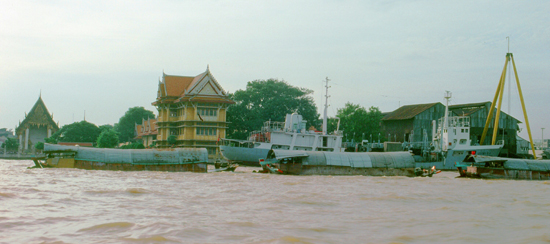 We went down some different canals, but many of the sights were the same, like these commercial craft. |
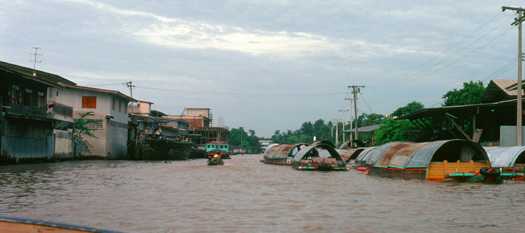 The further one goes up the canals, the narrower they get and, consequently, the more congested. |
Bangkok is in the Chao Phraya River delta, and the river meanders through the city. The area is flat and low-lying (an average elevation of 4 feet); most of it was originally swampland, which was gradually drained and irrigated for agriculture by the construction of canals (khlong) which took place from the 16th to 19th centuries. Some canals were also constructed to modify the course of the river.
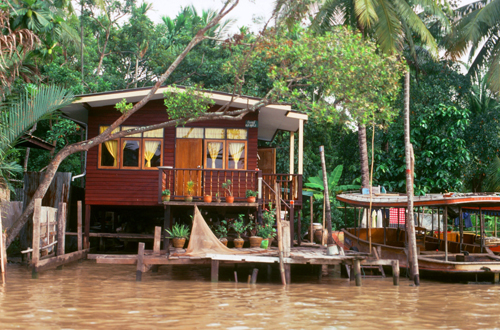 This was probably one of the nicest residences I saw, although not the largest by far. Unlike other areas, there is a plantation behind this structure. It was situated in an area where there were few buildings at all, since behind the house is a plantation. |
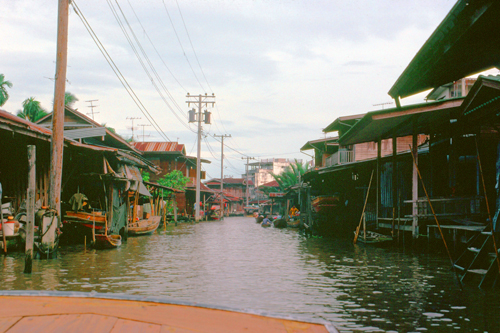 Much less appealing are these houses along a much narrower canal. In this part of the canal system, there is room for only two or three boats at a time to pass. |
The city's waterway network served as the primary means of transport until the late 19th century, when modern roads began to be built. Up until then, most people lived near or on the water, leading the city to be known during the 19th century as the "Venice of the East". Many of these canals have since been filled in or paved over, but others- almost all quite badly polluted, still criss-cross the city, serving as major drainage channels and transport routes.
|
Our visit here was an immensely interesting experience, even though these markets are not nearly as "authentic" as they used to be; they are not mostly in operation because they have become a hugely popular Thai tourist attraction. While this is the case, it is still true that many local Thais go to a floating market on the weekend to walk around, do some some shopping, and most importantly: to do some eating.
Today's market was a good deal larger than Taling Chan from yesterday, and there are a number of others situated on canals and waterways all around Bangkok- although only a few of them, like Khlong Lat Mayom, are easily accessible from the city center. Most tourists arrive by taxi or bus on the land side, but I was glad to arrive via a traditional Thai craft.
When I say "floating market", don’t think of Khlong Lat Mayom as that image of a thousand boats in the river, brimming with food and color. The actual “floating” part of the market is relatively small, because the waterway on which it is located is itself fairly small, and there are just a few vendors who mostly sell things like potted plants and flowers and fresh fruits and vegetables from their boats, with just a few restaurant boats. The "non-floating" part was much larger, with what was, essentially, a large farmers market combined with numerous stalls that were actually restaurants. There was at least one other unique attraction that I'll get to in a moment.
|
So markets like these are a lot of fun, for they offer the tourist an excellent opportunity to mingle with local residents who are doing their everyday things. (I can only imagine that some of the locals wish there weren't so many tourists getting in the way of their normal daily shopping excursions.
For most tourists, who have little need to take produce or other foods back to their hotels, it's the cooked and served food that attracts them to these markets. Although I wasn't hungry so early in the day, I have to say that there were choice in abundance, and that the food looked wonderful in display.
Although I didn't have much to eat, I could see how things worked. Just away from where our boat docked, there was an open area with some bamboo picnic tables, that are first-come-first-serve. People will grab a table and then start buying food from all the different stalls, and bringing everything back to their table to start eating. So what do they buy? I can't possibly remember all the foodstuffs that I saw; it all looked like entrees from an Oriental restaurant back home. One frequent sight were the large grills covered with salt-encrusted fish (seemingly hundreds of them), and so I assume that's a common thing that people buy. (I learned in researching this page that this was "pla pao", and indeed one of the best things to eat in these markets.
|
I actually did get a small amount to eat for my lunch, and chose a shrimp dish that came with some mungbean noodles. The shrimp were cooked very well- not overcooked and tough- and the noodles were flavored with (surprise, surprise) garlic, ginger, and pepper. It was quite good, and I didn't miss cocktail sauce at all, because the sauce the shrimp came with was nice and garlicky and a little spicy.
Although the food was good, what really caught my eye was that off to the side, under a large tree, a baby elephant was tied up, and I went over to have a look at it. I discovered that the idea is to buy these sticks of sugar cane, and hand-feed them to the elephant. While he looks real small, and easy to deal with, he is surprisingly strong, and it was difficult if not impossible for me to keep my place while a fellow tourist took this picture. I enjoyed feeding the cane to it; it was a cheap, too, at the equivalent of just fifty cents for a couple of sticks. This is one of my favorite pictures in this album, taken at just the right time, as the little animal decided to push against me.
Another reason tourists come to these markets is because they are also the starting point for many boat tours, and this market was no exception. Right at the center of the market along the canal were three or four of these, and boatmen hawking one-hour canal rides- most of which make a stop at the nearby Buddhist temple. When we left, we went by this temple, but did not stop there.
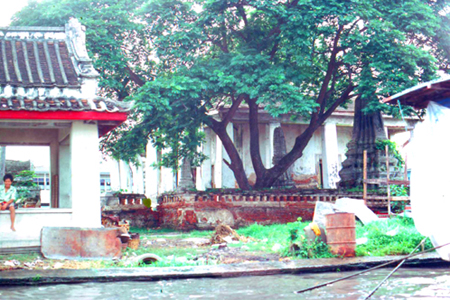 We passed a number of temples and other places of interest, including this one which was undergoing renovations. |
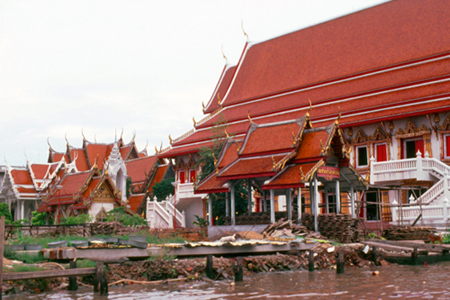 Here is another set of typical religious buildings, these right next to the canal. Even out and away from the city, the care and expense lavished on these buildings must be large. |
I was pleasantly surprised how good today's boat tour was, as we rode through canals- passing through neighborhoods, homes, gardens, small orchards, and businesses. In the old days of Bangkok, this was the only way to travel. And it's cheap, too, as the price I saw back at the floating marked was about $1 for a 1-hour ride.
Wat Arun
|
|
At right is a better view of the larger tower. It's not jammed with people, although there are a fair number who make the short climb up. The climb is not arduous, by any means, but the steps are incredibly steep.
A Buddhist temple has existed at the site of Wat Arun since the time of the Ayutthaya Kingdom (1350-1750). It was then known as Wat Makok, after the village of Bang Makok in which it was situated. According to the historian Prince Damrong Rajanubhab, the temple was shown in French maps during the reign of King Narai (1656–1688). The temple was renamed Wat Chaeng by King Taksin when he established his new capital of Thonburi near the temple, following the fall of Ayutthaya. It is believed that Taksin vowed to restore the temple after passing it at dawn. The temple enshrined the Emerald Buddha image before it was transferred to Wat Phra Kaew on the river's eastern bank in 1785 (I'll be going there tomorrow.). The temple was located on the grounds of the royal palace during Taksin's reign (I'll be visiting that tomorrow, too), before his successor, Rama I, moved the palace to the other side of the river. It was abandoned for a long period of time, until the reign of King Rama II (1809–1824), who had the temple restored and the main pagoda raised to 200 feet. The work was finished during the reign of King Rama III (1824–1851).
Our tour stopped here to give everyone an opportunity to walk around and climb the spire if they wished. I wished.
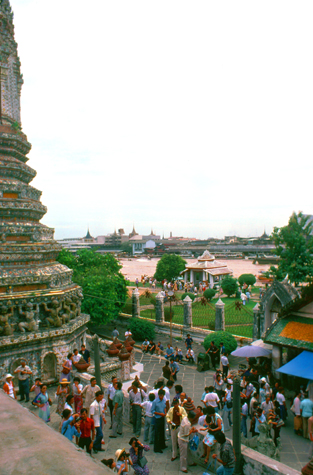 |
(Picture at left) This is taken from the base o the tower, just above the area where the boats leave off their passengers and there are souvenir shops and the like. As you can see, it stays busy.
(Picture at right)
|
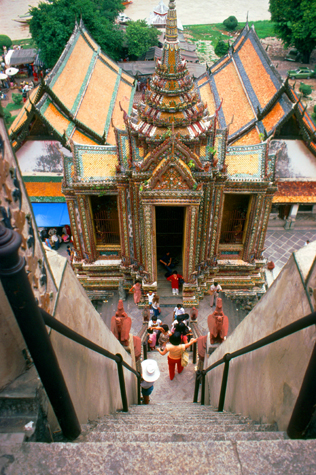 |
The temple underwent major restorations in the late 1800s, and I saw signs today indicating another restoration was getting underway. (A controversial renovation will take place between 2013-2017, and the results will draw some criticism for the temple's new appearance, which will seem to be white-washed compared to its previous state. So perhaps its good that I got to see the spires this year.
|
This is the view from the topmost point that people are allowed to go. The view looks west, away from the city itself, and as you can see, away from the downtown area the rest of the city is made up primarily of low buildings. There are very few tall buildings of any note on this side of the river, and it seems to me that the tallest building that I saw anywhere in Bangkok was perhaps ten or fifteen stories or so. Off in the distance you can see some taller structures, but if you look very carefully, you can see that most of these are also temples and monasteries. There is lots of room around the city, and I guess that's why there's no urge to build high.
(This will, of course, all change in the years after my visit here, and today, adjacent to the Hyatt Rama (now a Holiday Inn) there is a thirty-five story skyscraper, and there are others of similar height in the city.)
I like to take pictures from up high, particularly after it took so much effort to get up here, and here are a couple of them:
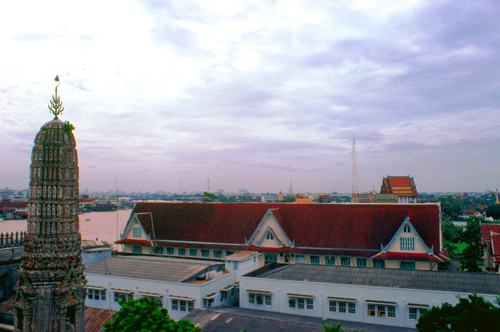 This entire complex is undergoing renovation, and you can see here the results of the completion on the large building in the center. I imagine that when the whole thing is finished, it will be quite lovely. Off to the right and left the buildings are getting thorough face-lifts. |
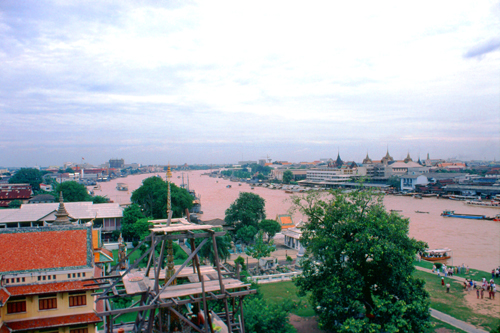 Here is the Chao Phraya River that winds through the city, along which much traffic passes. The weather on this day was not particularly bad, although it was quite warm and overcast. There was no rain until early evening. |
The central prang (the one I climbed) is topped with a seven-pronged trident, referred to by many sources as the "Trident of Shiva". Around the base of the prang are various figures of ancient Chinese soldiers and animals. In the Buddhist iconography, the central prang is considered to have three symbolic levels— the base for all realms of existence, the middle where all desires are gratified and the top denoting six heavens within seven realms of happiness.
|
As my final view from the top (where I am certainly happy to be), is the view to the east and the central portion of Bangkok. As you can see, there are few skyscrapers, although the building boom that will begin in about ten years will take care of that situation.
Next to the prang is the Ordination Hall with a Buddha image supposedly designed by King Rama II. The front entrance of the Ordination Hall is currently undergoing restoration; underneath the scaffolding is a roof with a central spire, decorated in coloured ceramic and stuccowork sheated in coloured china. There are two demons, or temple guardian figures, in front.
As you can see, there are no mountains in Bangkok. The closest mountains are about 25 miles southeast. There is only one hill in the metropolitan area, and even that is artificial. King Rama III (1787–1851) built a large chedi, a domelike structure used for prayers, at Wat Saket. The chedi collapsed during construction because the soft soil could not support its weight. Over the next few decades, the abandoned mud-and-brick structure acquired the shape of a natural hill and became overgrown with weeds. The locals named it as if it were a natural feature, and in the 1940s, enclosing concrete walls were added to stop the hill from eroding.
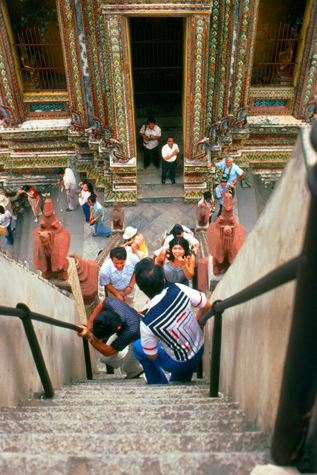 |
(Picture at left) Back at the stairs, here are some tourists leisurely strolling up the graceful stairways.
(Picture at right)
|
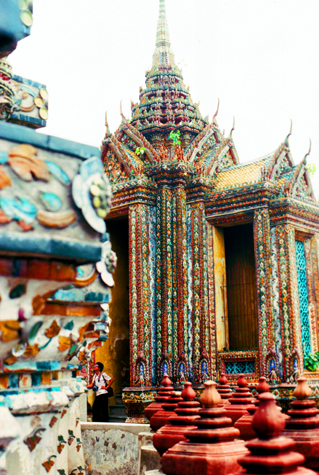 |
Speaking of the Nikko Shrine, I think it is interesting to compare the style of building here with that in Japan (and later, Hong Kong). Very great differences can be found in basic style, although there are many similarities in adornment. After spending an hour or so at Wat Arun, our group once again boarded our boat and we cruised the river for a while, eventually getting dropped off back at the dock on the east side of the river. This tour went so well that I resolved to ask at the hotel about another one tomorrow.
Since the previous day's tour was so well-run, I signed up for another as soon as the bus returned to the Hyatt. After I got that done, I went for a swim in the pool- which was interrupted when it rained quite heavily for a short time. I wasn't adventurous enough to go out and find a Thai restaurant to eat, so I ate in the hotel (although I did go out and find dessert at a street vendor).
Wat Phra Kaew (Temple of the Emerald Buddha)
|
The main building of the temple complex is the central phra ubosot, which houses the statue of the Emerald Buddha. An ubosot is a building in a Buddhist wat, and the phra ubosot is the holiest prayer room, also called the "ordination hall" as it is where ordinations take place. According to legend, this particular Buddha image originated in India where a sage prophesied it would bring "prosperity and pre-eminence to each country in which it resides".
The Emerald Buddha in the Wat Phra Kaew is therefore deeply revered and venerated in Thailand as the protector of the country. Historical records date its finding to the 15th century in China, and it was finally brought to Thailand and enshrined in this temple in 1782.
|
CC BY-SA 3.0 https://commons.wikimedia.org |
One of the first things we did was to enter the ubosot to see the actual Emerald Buddha. We were, our guide told us, fairly fortunate in that on this particular morning there were no special events going on in the Temple, as the ubosot is often closed for hours or all day at such times.
At the entrance to the ubosot, there were prominent signs that photography was not allowed, and so I had to put my camera away for the time we were inside the building. But I wanted you to know what the sculpture looked like, so, since I am writing this in 2019 and have access to the Internet, I have located an official picture taken of the statue; that picture is at left.
The Emerald Buddha, a dark green statue, is in a standing form, about 2 feet tall, carved from a single jade stone ("emerald" in Thai means deep green color and not the specific stone) in the meditating posture. No one but the Thai King is allowed to touch the statue, as he does three times a year to mark the summer, winter, and rainy seasons, an important ritual performed to bring good fortune to the country during each season.
Wat Phra Kaew has a number of buildings in its 50 acres. The architectural style is named "old Bangkok"; the main temple of the Emerald Buddha is decorated and similar to the temple in ancient capital of Ayutthaya. The roof is embellished with polished orange and green tiles, the pillars are inlaid with mosaics and the pediments are made of marble, installed in the 18th century. Over the years, the temple has retained its original design, but Thai rulers have, over the years, made minor improvements to it, including new woodwork, some additional chambers, and such, and the various frescoes and images have been cleaned and maintained.
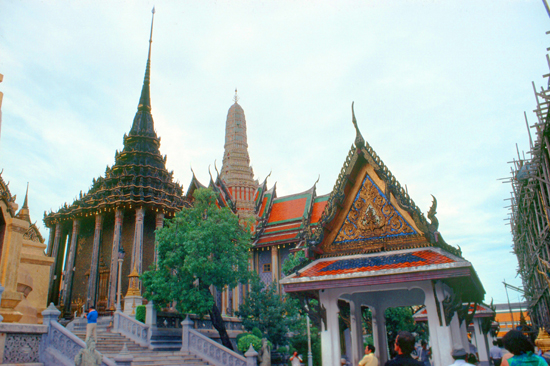 The library built by Rama I. The library has elegantly-carved Ayutthaya-style mother-of-pearl doors, bookcases holding sacred Buddhist manuscripts, human-and dragon-headed snakes, and images of Chakri kings. Our guide was always talking a mile a minute about everything, and I wish I could remember it all. |
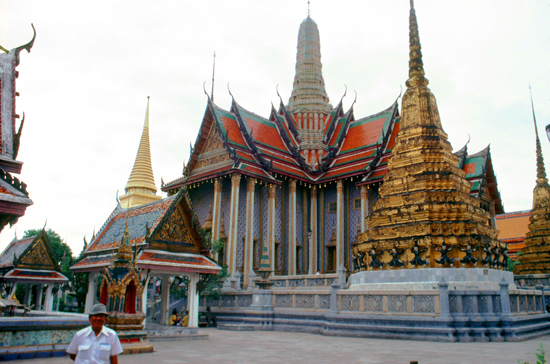 Here is our guide, Mr. Bakt, in front of the east end of the ubosot housing the Emerald Buddha. There are two golden chedi at this end of the building. These pyramidal structures house relics and other objects, and are usually ornately designed. |
The entire complex, including the temples, is bounded by a compound wall, one of the most prominent parts of the wat. It is about a mile and a quarter in length. The compound walls are decorated with Thai murals, which illustrate the Ramakian, the Thai national epic, which was written during the reign of Rama I. The murals serve to emphasise human values of honesty, faith, and devotion.
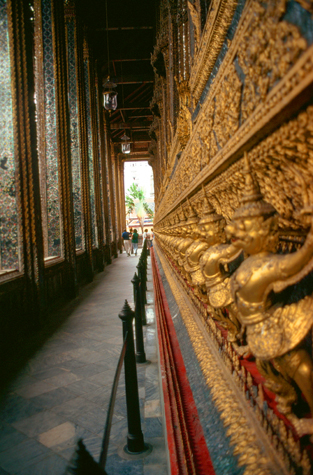 |
(Picture at left) We are just outside the temple in which the primary Buddha in the compound is kept. I wanted to show you the extreme intricacy of the hand-carvings done here, and give you some impression of the scope and size of the task as well. I was very impressed in that each figure was exactly like the next one, all without the benefits of machining. I have no idea what effort it must take to get everything so symmetrical, but I can imagine.
(Picture at right)
|
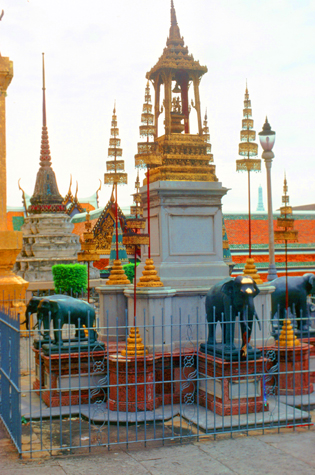 |
We spent two hours in the Temple of the Emerald Buddha before walking across the parade ground to the south to the Royal Palace.
The Grand Palace
|
Construction of the palace began on 6 May 1782, at the order of King Phutthayotfa Chulalok (Rama I), the founder of the Chakri Dynasty, when he moved the capital city from Thonburi to Bangkok. Throughout successive reigns, many new buildings and structures were added, especially during the reign of King Chulalongkorn (Rama V). By 1925, the king, the Royal Family and the government were no longer permanently settled at the palace, and had moved to other residences. After the abolition of absolute monarchy in 1932, all government agencies completely moved out of the palace.
In shape, the palace complex is roughly rectangular and has a combined area of some 200 acres, surrounded by four walls. It is situated on the banks of the Chao Phraya River (east side), just south of (and adjacent to) the Temple of the Emerald Buddha.
|
After that, we crossed the parade ground to the south to enter the actual grounds of the Grand Palace.
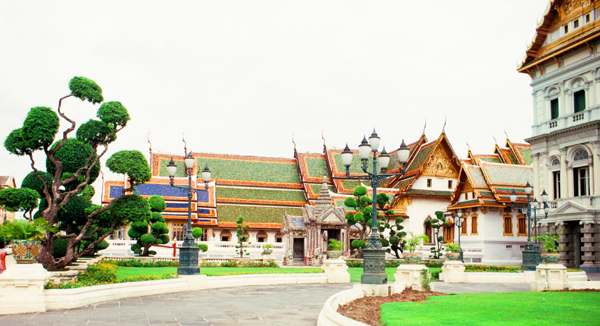 |
This brought us to the front of the Chakri Maha Prasat, or main palace building; on the diagram, it has the oval lawn just to the north of it. In that view above, I am looking to my left (east) at the throne hall and ceremonial hall. The extreme east end of the main palace is at the far right in the picture. From here, I can't exactly remember our route through the complex. Our guide took us in and out of buildings (where, sadly, photography was not allowed), talking all the time about the architecture and history of the complex and its buildings.
|
Again, it was very hard not to be impressed with the beauty of everything. Note the elephants guarding one of the entrances to the large palace at right. Also interesting is the use of color on the shingle roofs of the buildings. From this distance it looks as if the roof is colored Astroturf.
|
|
The throne hall (that term used to refer to the seat of government, rather than the actual ceremonial throne which is in the adjacent complex) forms the front or the façade of the entire building group. The lower part of the structure is European, while the upper part is in Thai-styled green and orange tiled roofs and gilded spires or prasats. King Rama V brought two English architects in to construct the building, and that construction began in 1876. At first the King wanted an entirely European structure with domes, but his Chief Minister influenced him to add the gilded spires and Thai roofs. The throne hall was completed in 1882.
The throne was constructed as part of a building group in a rotated 'H' shape plan, with two parallel buildings running on an east to west axis and an intersecting hall connecting them. When you look at the group from the north (as in the professional picture above, the other buildings are hidden behind it. The three-story building has three seven-tiered prasats on each of the three major pavilions along the axis, with the central one (my picture at left) being the taller.
Owing to the mix of Thai and European styles, the exterior decoration is a mixture of orders and does not follow strict classical lines. The Thai roofs were decorated to blend in harmoniously to the existing skyline. Above the middle floor windows the western style coat of arms of Siam is used. On the semi-circle pediment at the central hall there is also a portrait of King Rama V.
The incongruous make-up between the Western lower half and Thai roof has been thought to be symbolic of the superiority of Thai architecture (as a crown upon the head) over those of the West (the lower half of the body). This stylistic innovation was more than an artistic coincidence, as it was supposed to convey a significant political message of Siamese resistance over Western imperialism, both of sovereignty and style. From another perspective, the building itself epitomizes the internal political struggle between the ideas of Westernization and modernity (led by King Rama V) against those of the traditional ruling elites (as led by some of his early ministers). No photography was allowed inside, so describing the interior isn't all that helpful here. But you can imagine any capitol building in the US, change the architecture, add lots of colorful decoration, and add a bunch of actual thrones to imagine the interior of the Chakri Maha Prasat. There were state floors and residential areas, reception rooms, throne rooms, galleries, and lots of art.
A third group of buildings- the Phra Maha Prasat group- is situated on the westernmost part of the Middle Court. The main buildings within this area dates from the reign of King Rama I and contain some of the oldest existing edifices within the Grand Palace. The entire throne hall group is contained within a walled and paved courtyard. Similarly to the other two groups, the Maha Prasat buildings were built, embellished and refurbished over successive reigns. The building formed a single axis from north to south, with the public throne hall to the front and residential halls behind. Surrounding them are lesser functional halls and pavilion for used by the king and his court.
|
|
The spire carries a great deal of symbolism, section by section- the seven layers of heaven, a representation of the stupa in which the Buddha's ashes have been interred and, at the top, a tapered lotus bud or the crystal dew drop signifying the escape from the cycle of rebirths.
The pediments are decorated with the figure of Narayana riding on the back of a garuda, this figure symbolizes kingship and the king's association with the Hindu deity. The throne hall stands on a high base with convex and concave moldings. The bottom layer, according to Thai beliefs, resembles a lion's foot, the lion is a symbol of the Buddha's family and alludes to the Buddha's own royal heritage.
The most unusual feature of the throne hall is the small porch, projecting out at the front of the building. Under this porch stands the Busabok Mala Throne, whose spire echoes that of the larger building itself. The high base of the throne is surrounded by praying deities. During the reign of King Rama I, the throne was used when the king appeared before his vassal states; later it was used for certain ceremonies. The two doors to the hall is situated at the sides of the throne. Inside, the decoration was pretty amazing, and with lotus bud design on the painted walls and the coffered ceiling decorated with glass mosaic stars- reinforcing the impression of being in a heavenly abode. There are multiple thrones and much mother-of-pearl; some of them topped with the traditional royal nine-tiered umbrella.
|
This group is at the heart of the Grand Palace itself, with the group enclosed by a low wall, as this was once the residential and sleeping abode of kings. It is considered the most important set of throne halls in the entire Grand Palace. All of the buildings in the group face north and are arranged from front to back with the public reception hall being at the front, ceremonial halls in the middle and residential halls at the back, all of them connected.
All Royal coronations since that of King Rama II have taken place within the walls of this building group. Construction began in 1785 at the order of King Rama I, but construction continued for over a century. King after king resided within this building group, and each one added on to it. Except for the throne hall behind me in the picture at left, the rest of the complex is closed to the public.
The Thevaphibal Gate is the central entrance to the hall, however the central doorway is reserved exclusively for use by the king, others must enter through the two other doors on either side. As you can see, the doors are guarded by Chinese-style statues, including mythical warriors and lions. The gate is topped by three Thai-style spires covered in Chinese ceramics. We spent the next couple of hours wandering in and out of the various buildings and walked all around the complex. Here are some of the best of the pictures I took:
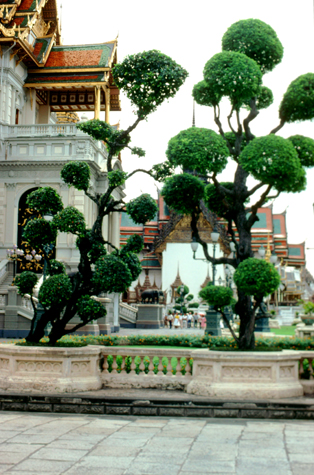 |
(Picture at left) This is a different view of the exterior of the Phra Maha Monthien group. I think the way they have cut the trees is amazing, and quite pleasant.
(Picture at right)
|
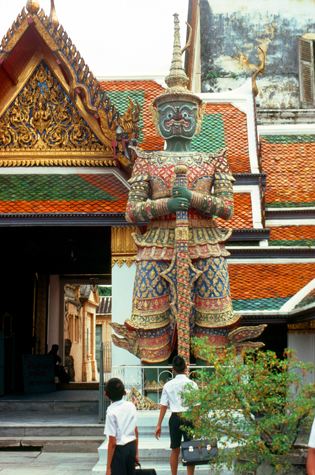 |
In many of my pictures you can see here how detailed the roof carvings are. Just above many lintels, for example, are figures very reminiscent of the Japanese carvings at Kyoto or Nikko. all along the roof edge, however, is the familiar bird-like shape found in Southeast Asia. The animal carvings are also similar, but it strikes me that here they are more stylized and abstract.
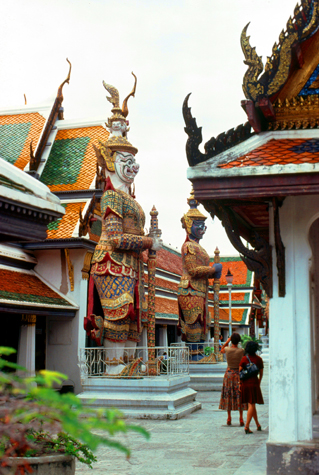 |
(Picture at left) Actually, as you can see, there is a pair of the figures, guarding the entrance to the inner court of the section of the government compound given over to religious buildings. Note again the tiles and roof carvings. I recall this day being fairly pleasant, if rather warm.
(Picture at right)
|
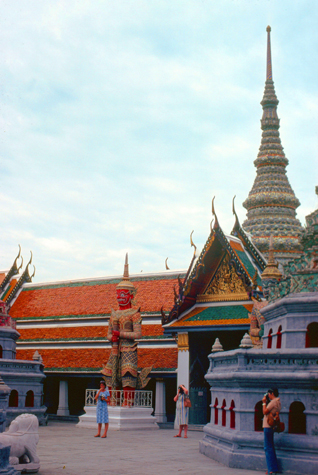 |
Some of the buildings we toured were quite large, but sprinkled among them were many smaller structures. And there was a whole garden area just to our east that we did not have time to walk through.
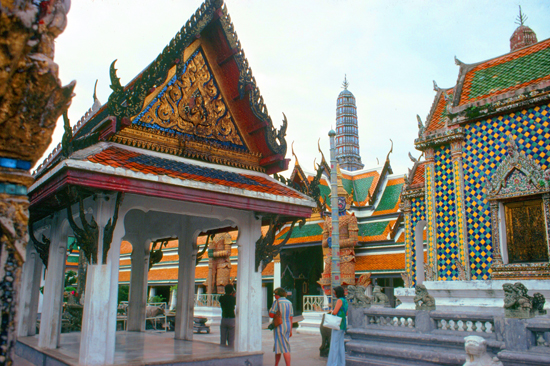 The Phra Thinang Sanam Chan is a traditional Thai pavilion with a raised platform inside. King Rama II used the pavilion for relaxation and for sitting when supervising construction projects. Measuring only 10 by 14, the pavilion was portable and could be moved to different sites. The wooden pediments are decorated with gilded carvings and glass mosaic in a floral design with Chinese and Western influences. The eight columns are inlaid with glass mosaic. The inner platform is decorated with black lacquer and glass mosaic. The top of the platform is made out of a single panel of teak. |
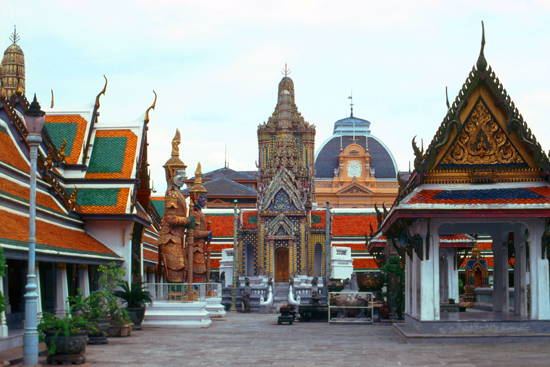 The two-storey Phra Thinang Boromphiman is the largest structure within the Siwalai Garden; it was constructed about 1900 by Rama V. This new palace was built over the site of an old armory, which the king had demolished. The new palace was intended as a gift to the first Crown Prince of Siam, but before construction was finished the prince died of typhoid at the age of 16. Once completed the palace was handed to the next heir, who ascended the throne in 1910 as Rama VI. |
As you can see from all these pictures, this whole area was very, very beautifully done. It just goes to show, I guess, what you can do with unlimited funds and manpower. It's good to be the king.
|
|
The residential hall was formed out of three identical rectangular buildings, all inter-connected to each other. The middle section of the residential hall, is a reception room while the other two sections, to the east and west, are divided into the personal apartments of the king. The east section is the primary bedchamber of the monarch; the hall is divided into two rooms by a golden screen. The northern room contains a canopied bed originally belonging to King Rama I; above this bed hangs a Royal Nine-tiered Umbrella. The southern room contains the dressing and privy chamber, above which hangs another nine-tiered Umbrella. The west section was used as a multi-purpose hall for minor ceremonies and audiences; however in the reign of King Rama III the hall was converted into a bedroom. After his death it became the storage place for the various weapons and accoutrements of the monarch. The Royal Regalia of Thailand is kept here.
This tour was a really excellent one, and the most beautiful things we saw we saw today. I was returned to the Hyatt Rama about six in the evening, where I had an early supper in preparation for my trip tomorrow over to Hong Kong.
Bangkok Postscript
What was missing, though, was the pervading feeling that the business of Bangkok was business. In a city like Sydney, the business is finance and shipping. In a city like Los Angeles, the business is entertainment; in New York, communications and finance; in Chicago, merchandising. Bangkok did not impress upon me a flavor like any of those. It was as if, amid the more common commercial goings-on, Bangkok served as the contemplative outlet for that part of Asia. It is really hard to describe. On the surface, the pace of life seemed as hectic as anywhere. But underneath, there was a sense of calm.
You can use the links below to continue to another photo album page.
 |
August 24-28: A Visit to Hong Kong |
 |
August 12-18: A Business Trip to Sydney |
 |
Return to Index for 1978 |